
Rocks and Geology Around Las Vegas

Fossils are a record of the history of life on Earth captured in stone. The breadth of time recorded in the rocks around Las Vegas spans almost half of the history of the Earth, and nearly the entire fossil record can be found here in sedimentary rocks. Around Las Vegas, fossils are most often found in carbonate rocks (e.g., corals, shells), but sometimes are found in sandstone (dinosaur and early mammal tracks), mudstone (petrified wood, animal tracks), and shale (trilobites).
Invertebrate fossils (e.g., corals, brachiopods, crinoids, and sponges) are common in the sedimentary rocks that make up the mountains around Las Vegas, and trilobites and gastropods can be found in a few places in these mountains too. Tracks of dinosaurs are recorded in the Jurassic sandstones of Red Rock Canyon, and the tracks of extinct birds and mammals can be seen in Cenozoic mudstones near Lake Mead. Petrified Wood is common at Valley of Fire and can be found at Red Rock Canyon. Even the bones of extinct ice-age mammals can be seen in the hills around town.
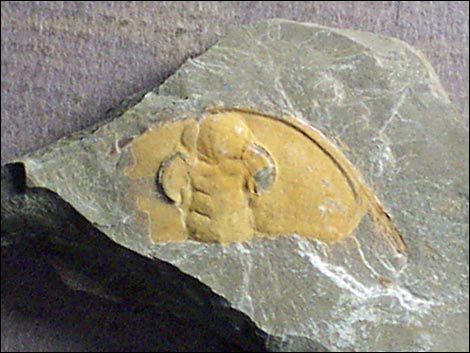 |
Invertebrates: Trilobites Trilobites are extinct marine arthropods of the class Trilobita that look much like modern horseshoe crabs. Trilobites are one of the earliest groups of arthropods, dating from the Early Cambrian to the Devonian (about 520 to 360 million years ago), although smaller numbers survived until the end of the Permian (250 mya). Like modern arthropods, trilobites had a hard exoskeleton and molted as they grew. As a result, great numbers of trilobite shell fragments can be found, but entire specimens are rare, making even a good cephalon a nice find. Trilobites can be found in a couple of places around Las Vegas. The closest is the base of Frenchman Mountain on the east side of the Las Vegas Valley. Most of the material here is fragmentary, but it is close to town. Trilobites can also be found south of Las Vegas near Chambless, California (Cadiz Trilobite Quarry and Chambless Trilobite Quarry), just west of Emigrant Pass on the Old Spanish Trail highway (Nopah Trilobite Quarry), and up towards Caliente (Oak Springs Trilobite Quarry). These sites are on BLM land where collecting small amounts for personal use is legal. |
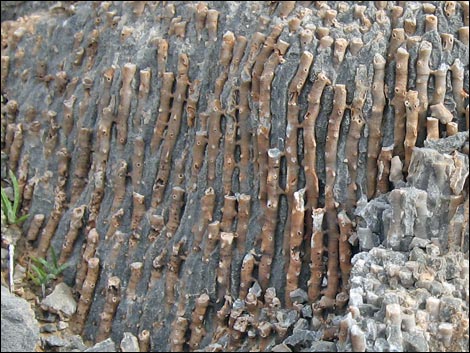 |
Invertebrates: Corals Corals are Cnidarians, and thus are related to sea anemones, jelly fish, and similar creatures. Corals are like tiny sea anemones with arms and stinging cells used for capturing prey. Corals are colonial or solitary, and both secrete calcium carbonate skeletons of various sizes and shapes that are characteristic of each species. Coral fossils found around Las Vegas date from the Ordovician period (about 470 million years ago) to the end of the Permian (about 250 mya), when all of these species went extinct. Other species of coral exist today, obviously, but these species all went extinct. Coral fossils are abundant in a few places around Las Vegas. A great place to see corals is Fossil Canyon at Red Rock Canyon National Conservation Area. A bit more difficult to get to, Yucca Peak in the Desert National Wildlife Range also has some nice coral fossils. Being protected areas, however, these are places to look and marvel, but leave the rock hammer at home and don't collect specimens. |
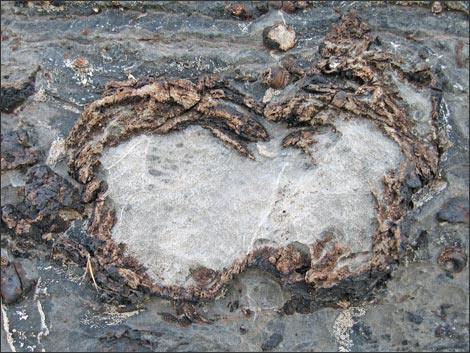 |
Invertebrates: Sponges Sponges are multicellular, aquatic animals in the phylum Porifera. Their general body plan is a tube, open at one end and closed at the other. The external wall has pores through which water is drawn into the body, then interior channels that circulate the water through their internal structures. Sponges filter food and absorb oxygen from the water, then expel the water and waste through the large opening at the end of the body. As fossils, sponges appear in many sizes and shapes, but generally somewhat spherical or elongate with multiple interior layers. A great place to see sponge fossils is Blue Diamond Hill at Red Rock Canyon National Conservation Area. Fossil Canyon and the other canyons above the Cowboy Trailhead are good places to look. Being a protected area, leave the rock hammer at home and don't collect specimens. |
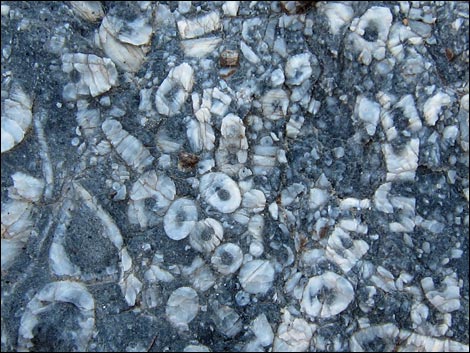 |
Invertebrates: Crinoids Crinoids are Echinoderms, thus related to starfish, sea urchins, sand dollars. Like these familiar creatures, they also have 5-point radial symmetry and lived in the sea. Crinoids look a bit like a feather-duster with the handle stuck to a rock and the feathers up in the water. A few hundred species of crinoids exist today, but in the past, they were much more diverse. Around Las Vegas, fossil crinoids can be found in many of the carbonate rocks dating from the Ordovician Period until the seas retreated from our area (about 485-250 mya). A few crinoids can be found at Fossil Canyon, but good places to find them are more difficult to visit. Yucca Peak (Desert NWR), the summit of Griffith Peak (Spring Mountain NRA), Corridor Canyon (Death Valley National Park) all have nice crinoids and other invertebrate fossils. Being protected areas, these places are closed to collecting. Crinoids can also be found in the Las Vegas Range along highway 93, where collecting small amounts for personal use is legal. |
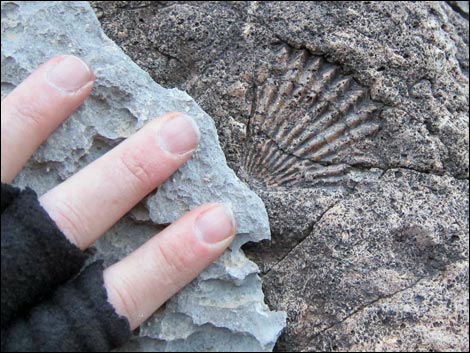 |
Invertebrates: Mollusc Shells Molluscs (Phylum Mollusca), especially bivalves (Class Bivalvia, clam-like creatures) and gastropods (Class Gastropoda, snail-like creatures) lived in the ancient seas that are now Las Vegas. Bivalves can occasionally be found in Paleozoic and Cenozoic sedimentary rocks, but gastropods are less frequently seen. A nice place to see Paleozoic bivalves is Blue Diamond Hill (Fossil Canyon Trail and Rock Garden Trail) at Red Rock Canyon NCA, and a nice place to see Cenozoic bivalves is along Cottonwood Wash in Lake Mead National Recreation Area. For gastropods, there is a nice outcrop in the Desert National Wildlife Range about 5 miles out the Mormon Well Road. Being protected areas, however, these are places to look and marvel, but leave the rock hammer at home and don't collect specimens. |
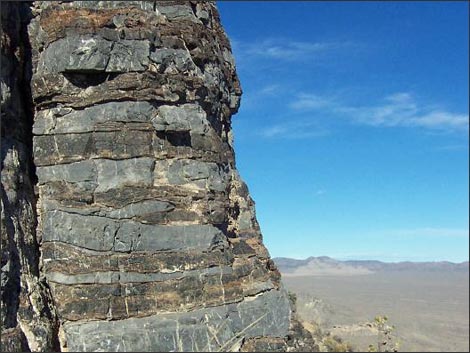 |
When the debris of life fall into water or plants and animals die in the ocean, sometimes they sink to the bottom and form an organic muck. Think of leaves and dead stuff rotting on the bottom of a pond. When the muck is covered up, such as by soil washing into the pond during flooding or limestone ooze settling over ocean-bottom muck, the muck can become fossilized. Around Las Vegas, fossilized muck is most often recognized as layers of unrecognizable "fossiliferous material" that punctuate layers of gray limestone. Occasionally, shells or other fossils can be seen in the muck, but usually it is simply reddish-brown, unrecognizable stuff. |
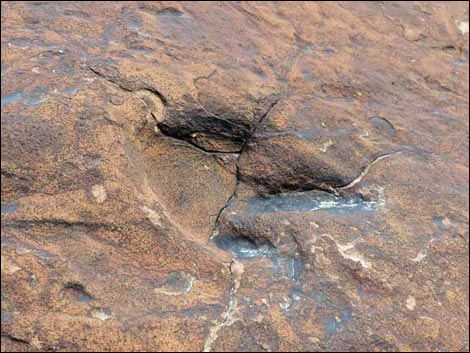 |
Vertebrates: Dinosaur Tracks Dinosaurs (Vertebrata, Reptilia) once wandered the Las Vegas landscape. So far as I know, dinosaur bones have not been found here, but they left their tracks in muddy sand dunes that became the red and white sandstone cliffs in the desert southwest. I won't say where, exactly, but tracks have been found at Red Rock Canyon National Conservation Area and Valley of Fire State Park. Don't even think about collecting vertebrate fossils in Nevada. Good places to see dinosaur tracks are the St. George (Utah) Dinosaur Discovery Site at Johnson Farm and in less-well developed sites around Moab, Utah. |
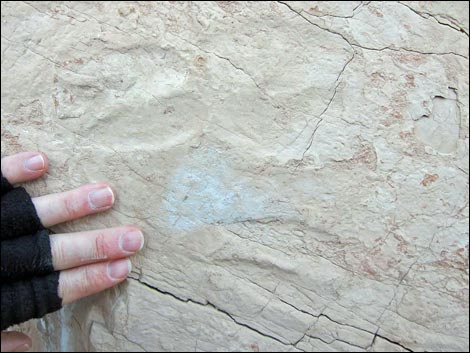 |
Vertebrates: Trace Fossils: Tracks and Burrows During ancient times, animals crawled around and burrowed into the bottom of ancient seas. In some places, their burrows filled with minerals that became stone. Near Sandy Valley, two low hills are covered with the casts of these burrows. It turns out that the material surrounding the burrows eroded faster than the burrow casts, leaving the casts scattered across the landscape (incidentally, looking much like fossilized dog poop). During the last several million years, mammals and birds wandered the landscape around Las Vegas. The tracks of extinct camels, wolves, and birds can be found in mudstones of Lake Mead National Recreation Area. |
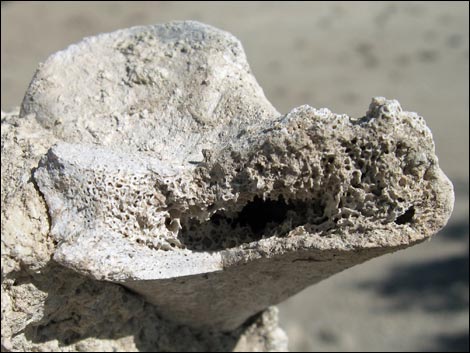 |
Vertebrates: Ice-Age Mammal Bones The bones of extinct ice-age mammals have be found in a few places around Las Vegas. Most notably, in the area north of Tule Springs in the recently proclaimed Tule Springs Fossil Beds National Monument. The area is generally open to the public, except for some sensitive sites. The state park visitor center is open with trails and educational opportunities, and scientific research continues. The bones of columbian mammoths, camelops (larger versions of bactrian camels), American lions, and wolves have been found at Tule Springs. This fossil-rich area is now protected forever in Tule Springs National Monument. Don't even think about collecting mammal fossils in Nevada. |
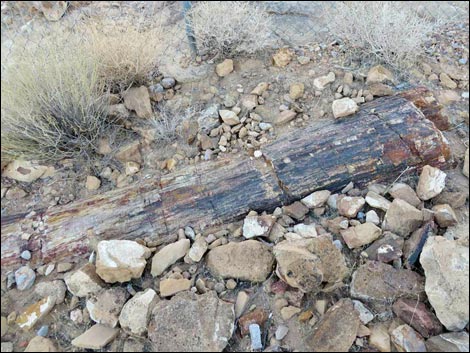 |
Plants: Fossilized Plants and Petrified Wood Hard to believe when looking around town, but back before dinosaurs, this area once was a forest of tall trees. The forest is long gone, but some of the logs were preserved as petrified wood. The best place to see petrified wood around Las Vegas is Valley of Fire State Park, but petrified wood can also be found at Red Rock Canyon National Conservation Area. Petrified wood can be found on BLM land where collecting small amounts for personal use is legal, but don't even think of collecting in conservation areas and state parks. Fossilized plants also occur in the Arrow Canyon Wilderness Area. |
Fossils of Unknown Taxonomy
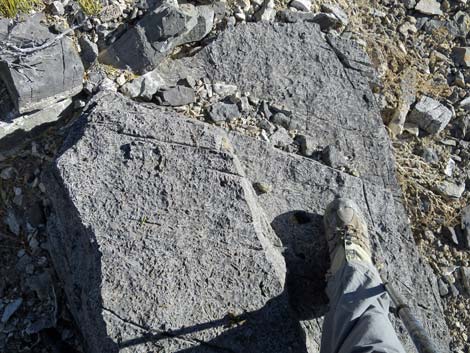 We see these white lines fairly often, but what are they? |
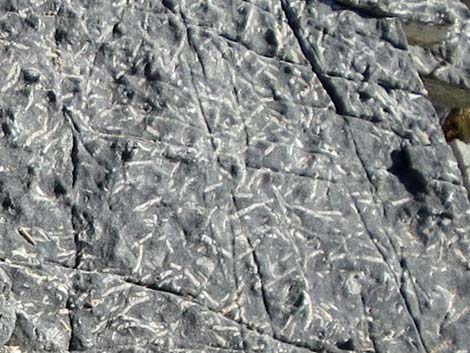 We see these white lines fairly often, but what are they? |
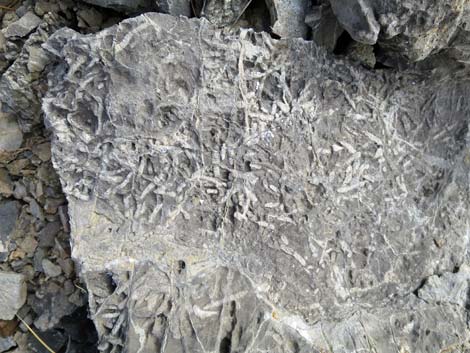 We see these white lines fairly often, but what are they? |
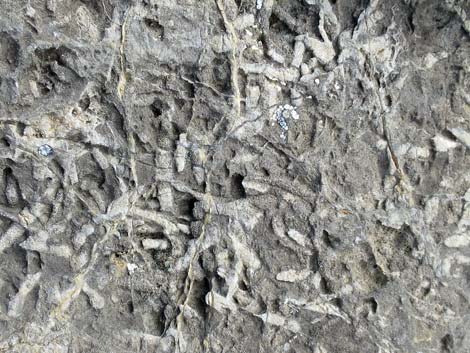 We see these white lines fairly often, but what are they? |
| Rocks and Geology | Hiking Around Las Vegas | Glossary | Copyright, Conditions, Disclaimer | Home |